The front desk uniforms market is estimated to grow from USD 1.1 billion in 2025 to USD 2 billion by 2035, advancing at a CAGR of 5.8%. The growth rate volatility index is a useful measure to evaluate how stable or fluctuating the expansion is likely to be over these ten years. It highlights the phases when growth may accelerate, moderate, or flatten, depending on broader economic conditions, the outlook of the hospitality sector, and seasonal hiring dynamics that directly influence uniform procurement cycles. While the long-term trajectory remains positive, the short-term movements tell an important story of resilience and adjustment within this niche apparel category.
From 2025 to 2030, the volatility index is expected to remain at a moderate level, as demand for front desk uniforms tends to move in line with hotel openings, refurbishment schedules, and tourism-led expansion. During this early phase, the strongest contribution is expected from mid-scale and upscale hospitality chains that are actively adding capacity in both developed and emerging markets. Shifts in design choices will accompany Volume growth in uniform purchases, as hotels increasingly seek modern, functional, and brand-consistent apparel that enhances guest perception. Short-term fluctuations may arise when travel demand softens due to external shocks or when capital expenditure on new properties slows down, but these are expected to be temporary, with recovery supported by tourism rebounds and international events.
Between 2030 and 2035, the volatility index is projected to decline, indicating that market expansion will stabilize. This reduced volatility stems from the maturity of procurement practices, as hospitality groups enter into long-term contracts with suppliers to ensure consistent design standards across chains. Standardized uniform policies are likely to be more widely implemented, particularly by international hotel brands seeking uniformity of guest experience across geographies. At the same time, the use of higher-quality, durable fabrics is expected to extend replacement cycles, making procurement more predictable and less subject to short-term swings. Technological integration into textiles, including innovations in wrinkle resistance, easy-care finishes, and temperature-regulating fabrics, will add value for hotel operators while reducing replacement needs.
An additional factor moderating volatility in the later years is the adoption of digital customization platforms, enabling hotels to personalize uniforms while managing inventory more efficiently. The gradual shift toward sustainable fabrics and eco-friendly procurement strategies may also stabilize procurement cycles, as these choices are usually embedded into long-term brand strategies rather than short-lived purchasing decisions. While seasonal or regional variations in tourism will continue to influence order volumes, the effect on overall market expansion is likely to be marginal. The growth rate volatility index therefore illustrates that despite short-term oscillations, the market for front desk uniforms remains firmly on an upward path, backed by predictable demand from hotels, resorts, and service-oriented businesses.
| Period | Primary Revenue Buckets | Share | Notes |
|---|---|---|---|
| Today | Cotton-based uniforms (hotels, corporate offices) | 62% | Traditional materials, standard designs |
| Polyester blend products | 28% | Performance fabrics, easy care | |
| Specialty materials | 10% | Premium applications, custom designs | |
| Future (3-5 yrs) | Advanced fabric systems | 48-52% | Moisture-wicking, wrinkle-resistant |
| Hotels & hospitality | 24-28% | Luxury hotels, boutique properties | |
| Corporate offices | 16-20% | Professional services, banking | |
| Retail & commercial | 12-16% | Shopping centers, service counters | |
| Healthcare facilities | 8-12% | Medical reception, clinic front desks | |
| Custom design services | 4-8% | Brand integration, specialized requirements |
The market demonstrates strong fundamentals with cotton-based uniform systems capturing a dominant share through superior comfort properties and professional appearance optimization. Hotels and hospitality applications drive primary demand, supported by increasing service quality requirements and brand presentation initiatives. Geographic expansion remains concentrated in developed markets with established hospitality infrastructure, while emerging economies show accelerating adoption rates driven by tourism development initiatives and rising service standards.
At-a-Glance Metrics
| Metric | Value |
|---|---|
| Market Value (2025) | USD 1.1 billion |
| Market Forecast (2035) | USD 2 billion |
| Growth Rate | 5.8% CAGR |
| Leading Material | Cotton Fabric Systems |
| Primary Application | Hotels & Hospitality Segment |
Primary Classification: The market segments by material type into cotton, polyester, and other materials, representing the evolution from traditional natural fibers to sophisticated blend technologies for comprehensive comfort and durability optimization.
Secondary Classification: Application segmentation divides the market into hotels & guesthouses, retail & commercial, corporate offices, healthcare facilities, and other applications, reflecting distinct requirements for appearance standards, durability specifications, and professional presentation.
Tertiary Classification: End-use segmentation covers hospitality chains, retail operators, corporate facilities, healthcare providers, and service organizations, while distribution channels span direct sales, uniform distributors, and specialized garment suppliers.
Regional Classification: Geographic distribution covers North America, Latin America, Western Europe, Eastern Europe, East Asia, South Asia Pacific, and Middle East & Africa, with developed markets leading adoption while emerging economies show accelerating growth patterns driven by hospitality industry expansion programs.
The segmentation structure reveals material progression from traditional cotton fabrics toward sophisticated blend systems with enhanced performance and care capabilities, while application diversity spans from luxury hospitality to professional corporate environments requiring precision appearance solutions.
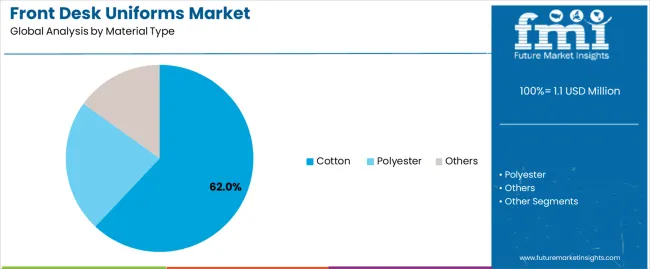
Market Position: Cotton uniform systems command the leading position in the front desk uniforms market with 62% market share through superior comfort properties, including breathable fabric construction, natural feel characteristics, and professional appearance optimization that enable hospitality operators to achieve optimal staff comfort across diverse front desk and reception environments.
Value Drivers: The segment benefits from hospitality industry preference for natural fabric systems that provide consistent comfort levels, reduced skin irritation concerns, and operational effectiveness optimization without requiring specialized care infrastructure. Advanced cotton processing features enable automated manufacturing systems, quality consistency, and integration with existing uniform programs, where material comfort and professional appearance represent critical service requirements.
Competitive Advantages: Cotton uniform systems differentiate through proven comfort reliability, natural fabric characteristics, and integration with standard laundering systems that enhance operational effectiveness while maintaining optimal appearance standards suitable for diverse hospitality and corporate applications.
Key material characteristics:
Polyester blend systems maintain a 28% market position in the front desk uniforms market due to their enhanced durability and easy-care advantages. These materials appeal to facilities requiring low-maintenance uniform solutions with extended wear performance for high-volume hospitality applications. Market growth is driven by operational efficiency expansion, emphasizing wrinkle-resistant solutions and maintenance cost optimization through advanced fabric designs.
Other specialty materials account for 10% market share, including premium fabric blends and performance textiles requiring specialized applications for luxury hospitality and executive environments.
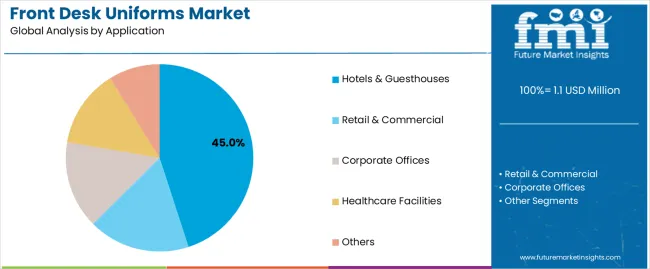
Market Context: Hotels and guesthouses applications show strong growth in the front desk uniforms market with a 6.2% CAGR and a 45% market share, driven by the expansion of hospitality services and an increasing focus on guest experience enhancement, operational brand consistency, and professional presentation initiatives that maximize service effectiveness while maintaining comfort standards.
Appeal Factors: Hospitality operators prioritize uniform reliability, appearance consistency, and integration with existing service infrastructure that enables coordinated operations across multiple hotel properties. The segment benefits from substantial hospitality industry investment and expansion programs that emphasize the acquisition of professional uniforms for staff differentiation and guest impression applications.
Growth Drivers: Tourism expansion programs incorporate front desk uniforms as essential components for guest service excellence, while hospitality chain growth increases demand for standardized appearance capabilities that comply with brand standards and minimize operational complexity.
Market Challenges: Varying brand requirements and property scale complexity may limit uniform standardization across different hotel chains or service scenarios.
Application dynamics include:
Retail & commercial applications capture 24% market share through specialized presentation requirements in shopping centers, service counters, and commercial facilities. These environments demand professional appearance solutions capable of supporting customer interaction requirements while providing reliable comfort access and operational durability capabilities.
Corporate office applications account for 18% market share, including reception areas, customer service centers, and professional services requiring sophisticated appearance capabilities for corporate optimization and professional effectiveness.
Healthcare facility applications maintain 12% market share through demanding hygiene requirements in medical reception, clinic front desks, and healthcare requiring specialized fabric capabilities for operational optimization and infection control.
Market Context: Hospitality chains dominate the market with 6.8% CAGR, reflecting the primary demand source for front desk uniform technology in hotel applications and service standardization operations.
Business Model Advantages: Hospitality chains provide direct market demand for professional uniform solutions, driving product innovation and capacity expansion while maintaining brand consistency and service quality requirements.
Operational Benefits: Hospitality chain applications include brand standardization, professional presentation, and quality assurance that drive consistent demand for uniform solutions while providing access to the latest fabric technologies.
| Category | Factor | Impact | Why It Matters |
|---|---|---|---|
| Driver | Hospitality industry growth & tourism expansion (service quality, professional presentation) | ★★★★★ | Growing tourism market requires professional staff appearance with exceptional comfort-to-durability ratios and presentation properties proven effective across hospitality applications. |
| Driver | Brand standardization requirements & corporate image (consistency, recognition) | ★★★★★ | Transforms uniform procurement from "optional" to "essential"; operators that offer standardized appearance and consistent quality gain competitive advantage. |
| Driver | Service quality enhancement & customer experience (professionalism, trust) | ★★★★☆ | Service industries need reliable, professional appearance solutions; demand for consistent and superior uniform solutions expanding addressable market. |
| Restraint | Price sensitivity & budget constraints (especially for small operators) | ★★★★☆ | Smaller hospitality operators defer uniform upgrades; increases cost sensitivity and slows professional appearance adoption in price-conscious markets. |
| Restraint | Alternative casual dress policies (business casual, relaxed standards) | ★★★☆☆ | Modern workplace trends offer flexible dress codes and reduced formality, potentially limiting uniform adoption in traditional business applications. |
| Trend | Technology integration & smart ordering systems (inventory management, size tracking) | ★★★★★ | Real-time inventory monitoring, size tracking, and automated ordering transform operations; technology integration and smart systems become core value propositions. |
| Trend | Customization & brand-specific designs (logos, colors, specialized features) | ★★★★☆ | Custom uniform properties for specific brands; specialized designs and targeted appearance capabilities drive competition toward customization solutions. |
The front desk uniforms market demonstrates varied regional dynamics with Growth Leaders including China (7.8% growth rate) and India (7.3% growth rate) driving expansion through hospitality development initiatives and tourism industry advancement. Steady Performers encompass Germany (6.7% growth rate), Brazil (6.1% growth rate), and developed regions, benefiting from established hospitality industries and professional service adoption. Mature Markets feature United States (5.5% growth rate), United Kingdom (4.9% growth rate), and Japan (4.4% growth rate), where service standardization and brand consistency requirements support steady growth patterns.
Regional synthesis reveals East Asian markets leading adoption through tourism expansion and hospitality development, while North American countries maintain steady expansion supported by service industry advancement and brand standardization requirements. European markets show strong growth driven by hospitality applications and tourism integration trends.
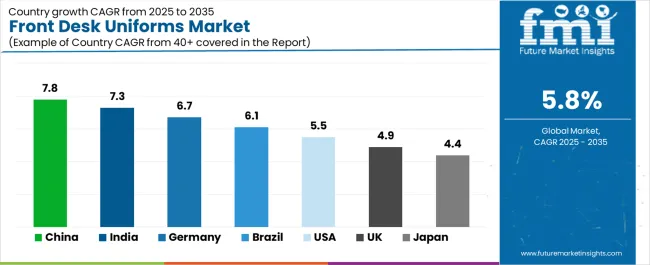
| Region/Country | 2025 to 2035 Growth | How to win | What to watch out |
|---|---|---|---|
| China | 7.8% | Focus on hospitality chain solutions | Regulatory changes; local competition |
| India | 7.3% | Lead with cost-effective programs | Import restrictions; quality standards |
| Germany | 6.7% | Provide premium quality uniforms | Over-regulation; lengthy approvals |
| Brazil | 6.1% | Offer value-oriented solutions | Currency fluctuations; import duties |
| United States | 5.5% | Push brand integration | Labor cost increases; scaling challenges |
| United Kingdom | 4.9% | Focus on hospitality applications | Economic uncertainty; material costs |
| Japan | 4.4% | Emphasize quality manufacturing | Traditional preferences; adoption rates |
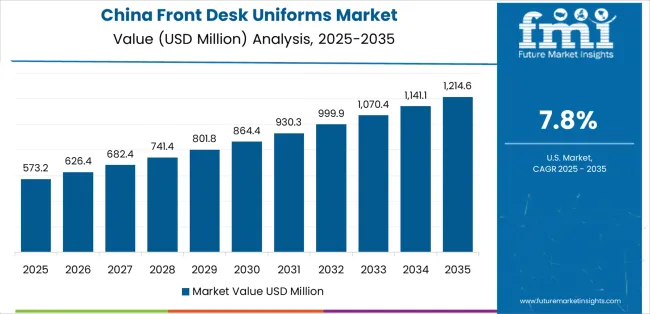
China establishes fastest market growth through aggressive hospitality development programs and comprehensive tourism industry expansion, integrating advanced front desk uniform systems as standard components in hotel facilities and hospitality installations. The country's 7.8% growth rate reflects government initiatives promoting tourism infrastructure and domestic hospitality capabilities that mandate the use of professional uniform systems in hotel and service facilities. Growth concentrates in major tourism hubs, including Beijing, Shanghai, and Guangzhou, where hospitality development showcases integrated uniform programs that appeal to hotel operators seeking professional appearance optimization capabilities and service excellence applications.
Chinese manufacturers are developing cost-effective uniform solutions that combine domestic textile advantages with professional appearance features, including automated ordering control and enhanced quality capabilities. Distribution channels through hospitality equipment suppliers and uniform distributors expand market access, while government support for tourism development supports adoption across diverse hospitality and service segments.
Strategic Market Indicators:
In Mumbai, Delhi, and Bangalore, hotel facilities and hospitality operators are implementing professional front desk uniform programs as standard equipment for service optimization and brand differentiation applications, driven by increasing government tourism investment and hospitality modernization programs that emphasize the importance of professional appearance capabilities. The market holds a 7.3% growth rate, supported by government tourism initiatives and hospitality development programs that promote professional uniform systems for hotel and service facilities. Indian operators are adopting uniform programs that provide consistent appearance standards and quality features, particularly appealing in urban regions where service differentiation and professional excellence represent critical operational requirements.
Market expansion benefits from growing hospitality capabilities and international hotel partnerships that enable domestic implementation of professional uniform systems for hospitality and service applications. Technology adoption follows patterns established in hospitality equipment, where reliability and appearance drive procurement decisions and operational deployment.
Market Intelligence Brief:
Germany's advanced hospitality market demonstrates sophisticated uniform deployment with documented appearance effectiveness in hotel applications and service facilities through integration with existing hospitality systems and operational infrastructure. The country leverages engineering expertise in textile technology and quality systems integration to maintain a 6.7% growth rate. Hospitality centers, including Bavaria, Baden-Württemberg, and North Rhine-Westphalia, showcase premium installations where uniform systems integrate with comprehensive hospitality platforms and facility management systems to optimize service operations and appearance effectiveness.
German manufacturers prioritize system precision and EU compliance in uniform development, creating demand for premium systems with advanced features, including facility integration and automated quality systems. The market benefits from established hospitality infrastructure and a willingness to invest in professional appearance technologies that provide long-term operational benefits and compliance with international hospitality standards.
Market Intelligence Brief:
Brazil's market expansion benefits from diverse tourism demand, including hospitality modernization in São Paulo and Rio de Janeiro, hotel facility upgrades, and government tourism programs that increasingly incorporate professional uniform solutions for service applications. The country maintains a 6.1% growth rate, driven by rising tourism activity and increasing recognition of professional appearance benefits, including precise brand consistency and enhanced service effectiveness.
Market dynamics focus on cost-effective uniform solutions that balance professional appearance performance with affordability considerations important to Brazilian hospitality operators. Growing tourism industrialization creates continued demand for modern uniform systems in new hotel infrastructure and hospitality modernization projects.
Strategic Market Considerations:
United States establishes market leadership through comprehensive hospitality programs and advanced service industry infrastructure development, integrating front desk uniform systems across hotel and corporate applications. The country's 5.5% growth rate reflects established hospitality industry relationships and mature professional appearance adoption that supports widespread use of standardized uniform systems in hospitality and corporate facilities. Growth concentrates in major hospitality centers, including California, Florida, and New York, where service technology showcases mature uniform deployment that appeals to hospitality operators seeking proven appearance capabilities and operational efficiency applications.
American hospitality providers leverage established distribution networks and comprehensive technical support capabilities, including validation programs and training support that create customer relationships and operational advantages. The market benefits from mature service standards and hospitality requirements that mandate uniform system use while supporting technology advancement and operational optimization.
Market Intelligence Brief:
United Kingdom's hospitality market demonstrates integrated uniform deployment with documented service effectiveness in hotel applications and hospitality facilities through integration with existing service systems and operational infrastructure. The country maintains a 4.9% growth rate, supported by hospitality innovation programs and service effectiveness requirements that promote professional uniform systems for hospitality applications. Hotel facilities across England, Scotland, and Wales showcase systematic installations where uniform systems integrate with comprehensive service platforms to optimize hospitality operations and guest outcomes.
UK hospitality providers prioritize system reliability and industry compatibility in uniform procurement, creating demand for validated systems with proven service features, including quality monitoring integration and automated ordering systems. The market benefits from established hospitality infrastructure and service requirements that support professional appearance adoption and operational effectiveness.
Market Intelligence Brief:
Japan's market growth benefits from precision hospitality demand, including advanced hotel facilities in Tokyo and Osaka, service integration, and quality enhancement programs that increasingly incorporate uniform solutions for hospitality applications. The country maintains a 4.4% growth rate, driven by hospitality technology advancement and increasing recognition of precision appearance benefits, including accurate brand consistency and enhanced service outcomes.
Market dynamics focus on high-precision uniform solutions that meet Japanese quality standards and service effectiveness requirements important to hospitality operators. Advanced hospitality technology adoption creates continued demand for sophisticated uniform systems in hotel facility infrastructure and service modernization projects.
Strategic Market Considerations:
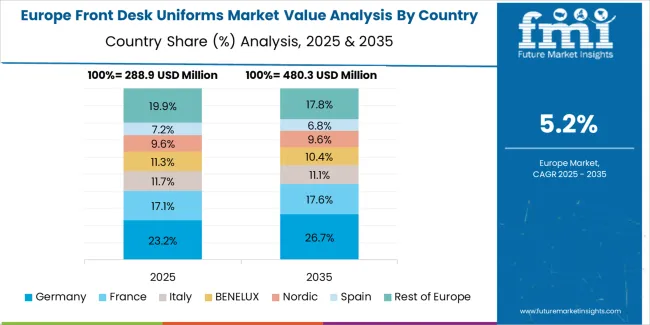
The European front desk uniforms market is projected to grow from USD 312.4 million in 2025 to USD 558.7 million by 2035, registering a CAGR of 6.0% over the forecast period. Germany is expected to maintain its leadership position with a 38.2% market share in 2025, supported by its advanced hospitality infrastructure and major tourism centers.
United Kingdom follows with a 24.7% share in 2025, driven by comprehensive hospitality programs and service excellence development initiatives. France holds a 18.5% share through specialized luxury hospitality applications and tourism compliance requirements. Italy commands a 12.1% share, while Spain accounts for 6.5% in 2025. The rest of Europe region is anticipated to gain momentum, expanding its collective share from 6.8% to 7.2% by 2035, attributed to increasing hospitality adoption in Nordic countries and emerging tourism facilities implementing hospitality modernization programs.
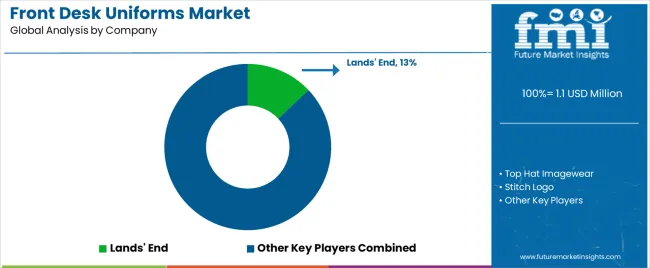
| Stakeholder | What they actually control | Typical strengths | Typical blind spots |
|---|---|---|---|
| Global platforms | Distribution reach, broad product catalogs, technical support networks | Wide availability, proven quality, multi-region support | Product refresh cycles; customer dependency on service validation |
| Hospitality specialists | R&D capabilities; advanced fabric technologies; enhanced design properties | Latest technologies first; attractive ROI on appearance effectiveness | Service density outside core regions; scaling complexity |
| Regional suppliers | Local compliance, fast delivery, nearby technical support | "Close to site" support; pragmatic pricing; local regulations | Technology gaps; talent retention in technical support |
| Brand-focused ecosystems | Design validation, customization development, brand support | Lowest technical risk; comprehensive support | Service costs if overpromised; design obsolescence |
| Niche specialists | Specialized applications, custom designs, hospitality support | Win luxury/premium applications; flexible configurations | Scalability limitations; narrow market focus |
| Item | Value |
|---|---|
| Quantitative Units | USD 1.1 billion |
| Material Type | Cotton, Polyester, Others |
| Application | Hotels & Guesthouses, Retail & Commercial, Corporate Offices, Healthcare Facilities, Others |
| End Use | Hospitality Chains, Retail Operators, Corporate Facilities, Healthcare Providers, Service Organizations |
| Regions Covered | North America, Latin America, Western Europe, Eastern Europe, East Asia, South Asia Pacific, Middle East & Africa |
| Countries Covered | China, India, Germany, Brazil, United States, United Kingdom, Japan, Canada, France, Australia, and 25+ additional countries |
| Key Companies Profiled | Lands' End, Top Hat Imagewear, Stitch Logo, Cintas, Finery, STOCK Vestis, Polo Garments, JA Uniforms, MF Clothing, Leeline Work |
| Additional Attributes | Dollar sales by material type and application categories, regional adoption trends across East Asia, North America, and Western Europe, competitive landscape with uniform manufacturers and hospitality suppliers, hospitality operator preferences for appearance effectiveness and service reliability, integration with hospitality platforms and inventory management systems, innovations in fabric technology and design enhancement, and development of advanced uniform solutions with enhanced comfort and professional optimization capabilities. |
The global front desk uniforms market is estimated to be valued at USD 1.1 billion in 2025.
The market size for the front desk uniforms market is projected to reach USD 2.0 billion by 2035.
The front desk uniforms market is expected to grow at a 5.8% CAGR between 2025 and 2035.
The key product types in front desk uniforms market are cotton , polyester and others.
In terms of application, hotels & guesthouses segment to command 45.0% share in the front desk uniforms market in 2025.






Full Research Suite comprises of:
Market outlook & trends analysis
Interviews & case studies
Strategic recommendations
Vendor profiles & capabilities analysis
5-year forecasts
8 regions and 60+ country-level data splits
Market segment data splits
12 months of continuous data updates
DELIVERED AS:
PDF EXCEL ONLINE
Frontotemporal Disorders Treatment Market Size and Share Forecast Outlook 2025 to 2035
Frontotemporal Dementia (FTD) Management Market – Trends & Future Outlook 2025 to 2035
Front Collision Warning Market Growth – Trends & Forecast 2025 to 2035
Front Office BPO Services Market – Digital Disruption 2034
Front forks Market
Wavefront Aberrometers Market Size and Share Forecast Outlook 2025 to 2035
Bicycle Front Hub Market Size and Share Forecast Outlook 2025 to 2035
Adaptive Front Lighting Market Growth - Trends & Forecast 2025 to 2035
Automotive Front and Rear Phygital Shield Market Size and Share Forecast Outlook 2025 to 2035
Automotive Front Windshield Market Size and Share Forecast Outlook 2025 to 2035
Automotive Front End Module Market Growth - Trends & Forecast 2025 to 2035
Radio Frequency Front End Module Market Size and Share Forecast Outlook 2025 to 2035
Automotive Engine Front Module Market Size and Share Forecast Outlook 2025 to 2035
Desktop CNC Milling Machines Market Size and Share Forecast Outlook 2025 to 2035
Desktop as a Service (DaaS) Market Size and Share Forecast Outlook 2025 to 2035
Desktop Outsourcing Market
Helpdesk Management Market
Help Desk Software Market Size and Share Forecast Outlook 2025 to 2035
Remote Desktop Software Market Insights – Growth & Forecast 2024-2034
Standing Desk Market Size and Share Forecast Outlook 2025 to 2035

Thank you!
You will receive an email from our Business Development Manager. Please be sure to check your SPAM/JUNK folder too.
Chat With
MaRIA